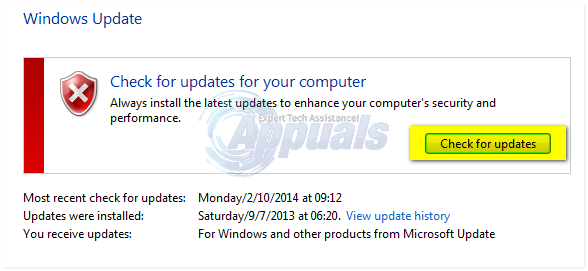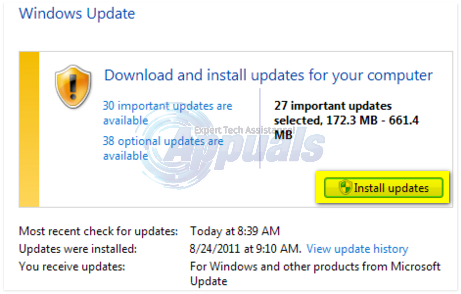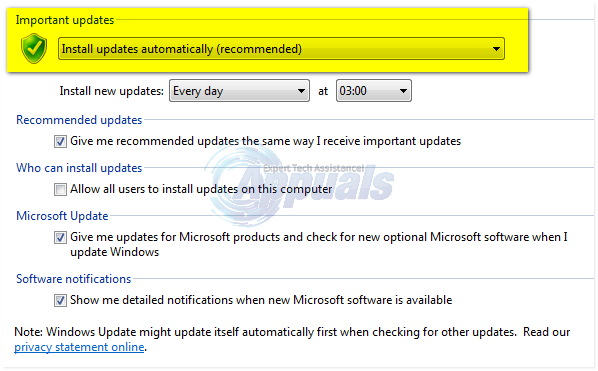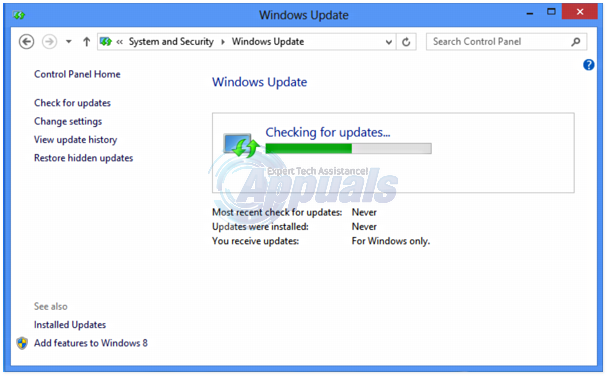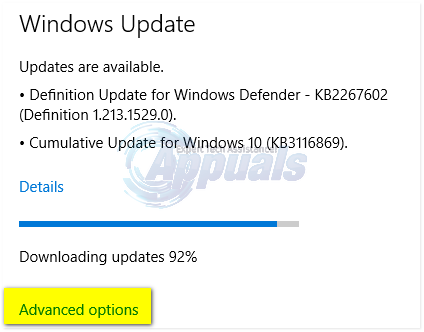- BEST GUIDE: How to Manually Run Windows Updates (7/8/8.1 and 10)
- How to Check If Your Windows Updates are Up to Date
- Windows 7/8/8.1
- Windows 10
- How to Run Windows Updates Manually in Windows 7
- How to Run Windows Updates Manually in Windows 8 and 8.1
- How to Run Windows Update Manually in Windows 10
- Run command for Windows update
- Windows Update: FAQ
BEST GUIDE: How to Manually Run Windows Updates (7/8/8.1 and 10)
Microsoft updates are continuously released and by default applied and installed on your Windows OS. It is important to let the updates install automatically; because they bring in numerous benefits in terms of security and keeping the software’s and service up to date; The top most reason technically is the security of your operating system. Since there are 100’s of services running on your system, they can become outdated, unreliable and insecure which is when Microsoft pushes an update to patch the system, or update the service or the program. If you don’t run updates regularly; then your computer could be at risk; especially if it connected to a network.
By default; updates are supposed to run automatically. If for any reason they are not; then you will usually be prompted with an Error Number which can help diagnose the issue.
The aim of this guide is to show how you can make sure that your system is updated and if incase something goes wrong with your Windows Update; then how to push Windows Manually to do the updates and also ensure that you’r e set to receive updates automatically.
How to Check If Your Windows Updates are Up to Date
The easiest way to do this is to click on Start, type Windows Update and Click On It.
Windows 7/8/8.1
Windows 10
see below. It’s easier in Windows 10 therefore exclusive steps are not needed.
How to Run Windows Updates Manually in Windows 7
Press the Windows key on your keyboard. In the search box, type Windows update. In the search results, click on Windows update. Click on Check for updates in the right pane. It will start checking for the latest updates.
If there are any updates available, they will be listed underneath. After it has found updates, you will see an option called Install Updates. Click on it to begin installing updates.
Click Install updates to install them. Click Yes if the UAC warning message appears. You may see a license agreement, click I accept the license terms and click Finish. Updates will start downloading and installing automatically. A reboot maybe required so do it. It may install updates while shutting down and powering on. Be patient, and let the process complete.
Once done; the next step is to ensure that your system is set to install and check updates automatically. To do this, click Change Settings from the left pane; and set the first option to “Install Updates Automatically (Recommended)”
How to Run Windows Updates Manually in Windows 8 and 8.1
Hold the Windows Key and Press X. Choose Command Prompt (Admin)
wuauclt /showcheckforupdates
Windows update’s window will appear and automatically start checking for updates. If there are updates available for your system, click Install to download and install them automatically.
You may be asked to restart your system, click Restart now. It may install updates while shutting down and powering on. Be patient, and let the process complete.
How to Run Windows Update Manually in Windows 10
Hold the Windows Key and Press R. In the run dialog, type the following command
ms-settings:windowsupdate
Windows update’s window will appear. Click on Check for updates. It will start checking for updates. Click Install if any updates are available. This can take a while, and even a couple of reboots. Once done; click on Advanced Options;
then make sure that Automatic (Recommended) option is selected under Choose How Updates Are Installed.
Run command for Windows update
There are couple of Run commands for Windows update. The run commands are very handy to launch an application quickly without the need to find the same in list of programs or on filesystem. WindowsВ has a run command for almost every application or configuration tool.
The run commands for Windows update are wuapp (or) control update . So to launch Windows update from Run, you need to perform the below steps.
- OpenВ Run with [Win]+[R] shortcut or from Start menu.
- Type in either of ‘wuapp’ or ‘control update’ and press ‘Enter’
This launches windows update configuration window. Here you can click ‘Settings’ and then configure how you want to install updates on to your computer.
If you just want to trigger updates click on ‘Check for updates’. Note that there’s no run command that can trigger update directly
For Windows 10 the run command is:
ms-settings:windowsupdate
I prefer run commands over other ways as it seems faster to me. Here are some run commands which I use daily for opening various windows applications .
On screen Keyboard – osk
Calculator – calc
WordPad – write
Windows Media Player – wmplayer
Windows Fax and Scan – wfs
Snipping Tools – snippingtool
Paint – mspaint
Notepad – notepad
Task manager – taskmgrt/
Sticky Notes – stikyno
For Windows v1809+ I find this works from the command line:
You can also stop & start the Windows Update service prior:
Windows Update: FAQ
Note: If you’re looking for Microsoft Office update info, see Install Office updates.
In Windows 10, you decide when and how to get the latest updates to keep your device running smoothly and securely. When you update, you’ll get the latest fixes and security improvements, helping your device run efficiently and stay protected. In most cases, restarting your device completes the update. Make sure your device is plugged in when you know updates will be installed.
If other questions come up when you update Windows 10, here are some other areas that might interest you:
When you only want info about updating Windows 10, you’ll find answers to many of your questions here:
When the Windows 10 May 2020 Update is ready for your device, it will be available to download and install from the Windows Update page in Settings. Choose a time that works best for you to download the update. You’ll then need to restart your device and complete the installation. After that, your device will be running Windows 10, version 2004.
To manually check for the latest recommended updates, select Start > Settings > Update & Security > Windows Update > Windows Update .
To get help updating to the latest version of Windows 10, go to the Microsoft software download page and download the Update Assistant.
Some updates may not be available on all devices at the same time—we’re making sure updates are ready and compatible.
To stay up to date, select Start > Settings > Update & Security > Windows Update > Windows Update , and then select Check for updates.
If a feature update is available for your device, it will appear separately on the Windows Update page. To install it, select Download and install now.
Here are a few things you can try if you’re having trouble installing updates:
Make sure that your device is connected to the internet. Downloading updates requires an internet connection.
If you’re connected the internet, try to install the updates manually. Select Start > Settings > Update & Security > Windows Update > Windows Update , and then view available updates.
Check for updates
Run the Windows Update Troubleshooter. Select Start > Settings > Update & Security > Troubleshoot . Under Get up and running, select Windows Update.
The time required to download updates primarily depends on internet connection speed, network settings, and update size. Make sure your device is plugged in and connected to the internet to download updates faster.
You can’t stop updates entirely—because they help keep your device safe and secure, updates will eventually need to be installed and downloaded, regardless of your update settings. Here’s how to temporarily pause updates from being downloaded and installed. Note that after the pause limit is reached, you’ll need to install the latest updates before you can pause updates again.
In the Windows 10 November 2019 Update (version 1909) or later, or in Windows version 1809 for Pro or Enterprise, select Start > Settings > Update & Security > Windows Update . Then choose one of the following options:
Select Pause updates for 7 days.
Select Advanced options. Then, in the Pause updates section, select the drop-down menu and specify a date for updates to resume.
To finish installing an update, your device will need to restart. Windows will try to restart your device when you’re not using it. If it can’t, you’ll be asked to schedule the restart for a more convenient time. Or, you can schedule anytime by following these steps:
Select Start > Settings > Update & Security > Windows Update > Windows Update .
Select Schedule the restart and choose a time that’s convenient for you.
You can set active hours to make sure automatic restarts for updates only happen when you’re not using your device. Learn about active hours for Windows 10.
Try deleting files you don’t need, uninstalling apps you don’t use, or moving files to another drive like an external USB drive or OneDrive. For more tips on freeing up disk space, see Free up drive space in Windows 10.
We recommend keeping devices like laptops and tablets plugged in when you’re not using them. This way, if updates are installed outside active hours, your device will have enough power to complete the installation. Windows updates don’t consume more battery than other typical system processes.
An update history is available so you can see which updates were installed, and when. You can also use this list to remove specific updates, although we don’t recommend this unless it’s necessary.
Select Start > Settings > Update & Security > Windows Update > Windows Update > View update history .
For more info about what’s included in updates for Windows 10, see Windows 10 update history.
We don’t recommend that you remove any installed updates. However, if you must remove an update, you can do so in update history.
Select Start > Settings > Update & Security > Windows Update > View update history > Uninstall updates.
Select the update you want to remove, then select Uninstall.
Feature updates are typically released twice per year and include new functionality and capabilities as well as potential fixes and security updates. Quality updates are more frequent and mainly include small fixes and security updates. Windows is designed to deliver both kinds of updates to devices through Windows Update.
To double check that your device is up to date, open Settings > Update & Security > Windows Update and see your update status and available updates.
To find which version of Windows you’re running, see Which version of Windows operating system am I running?
Reserved storage is not automatically turned on by Windows in any update scenarios. It is only turned on for new devices with the Windows 10 May 2019 Update (version 1903) or later preinstalled, or devices on which a clean install was performed.
Note: If you’re looking for Microsoft Office update info, see Install Office updates.
The best way to keep Windows 8.1 up to date is to turn on automatic updates. With automatic updates, you don’t have to search for updates online or worry about missing critical fixes or device drivers for your PC. Instead, Windows Update automatically installs important updates as they become available.
To turn on automatic updates:
Open Windows Update by swiping in from the right edge of the screen (or, if you’re using a mouse, pointing to the lower-right corner of the screen and moving the mouse pointer up), select Settings > Change PC settings > Update and recovery > Windows Update. If you want to check for updates manually, select Check now.
Select Choose how updates get installed, and then, under Important updates, select Install updates automatically (recommended).
Under Recommended updates, select Give me recommended updates the same way I receive important updates.
Under Microsoft Update, select Give me updates for other Microsoft products when I update Windows, and then select Apply.
Click the questions below to see answers about how Windows Update keeps your device up to date.
Note: If your PC is connected to a network where updates are managed by Group Policy, you might not be able to change settings related to Windows Update. For more info, contact your organization’s technical support.
Open Windows Update by swiping in from the right edge of the screen (or, if you’re using a mouse, pointing to the lower-right corner of the screen and moving the mouse pointer up), select Settings > Change PC settings > Update and recovery > Windows Update. To check for updates manually, select Check now.
An update history is available so you can see which updates were installed, and when. You can also use this list to remove specific updates, although we don’t recommend this unless it’s necessary.
To see your PC’s update history, open Windows Update by swiping in from the right edge of the screen (or, if you’re using a mouse, pointing to the lower-right corner of the screen and moving the mouse pointer up), select Settings > Change PC settings > Update and recovery > Windows Update > View your update history.
We don’t recommend that you remove any installed updates. However, if you must remove an update, you can do so in update history.
Open Windows Update by swiping in from the right edge of the screen (or, if you’re using a mouse, pointing to the lower-right corner of the screen and moving the mouse pointer up), select Settings > Change PC settings > Update and recovery > Windows Update > View your update history.
Select the update you want to remove, then select Uninstall.
Here are a few things to try if you’re having problems installing updates:
Make sure that your PC is connected to the internet. Some updates can’t be installed if you’re using a metered internet connection.
If you’re connected the internet and updates aren’t installed automatically, wait a few minutes and then try to install the updates manually.
See the Fix Windows Update errors guided walkthrough to try to fix the problem.
Support for Windows 7 ended on January 14, 2020
We recommend you move to a Windows 10 PC to continue to receive security updates from Microsoft.
Click the questions below to see answers about how Windows Update keeps your device up to date.

